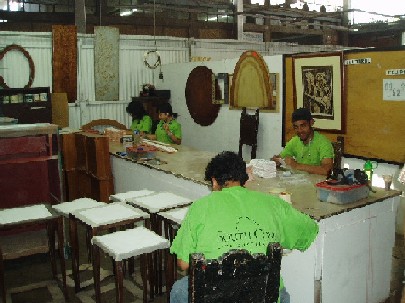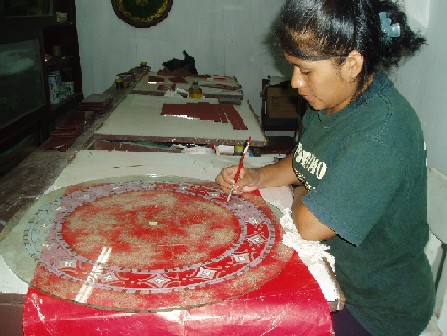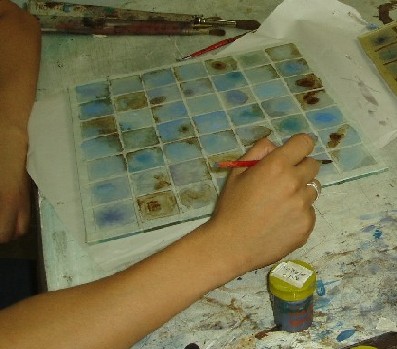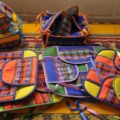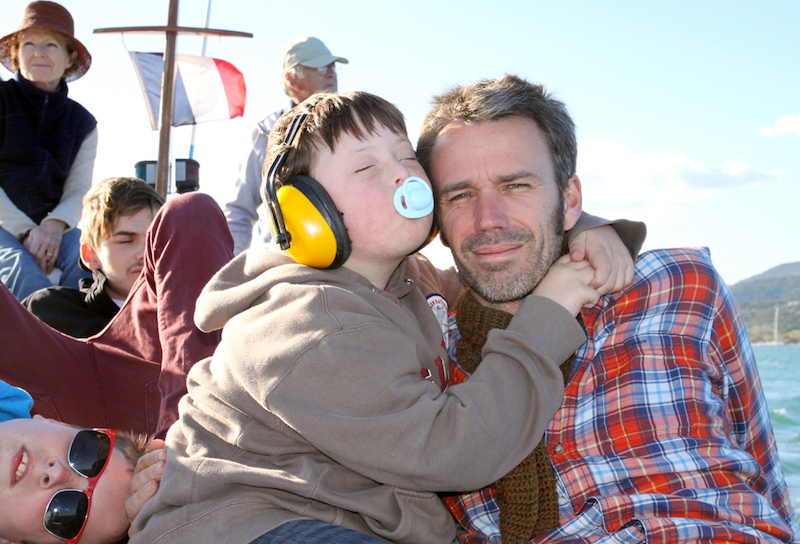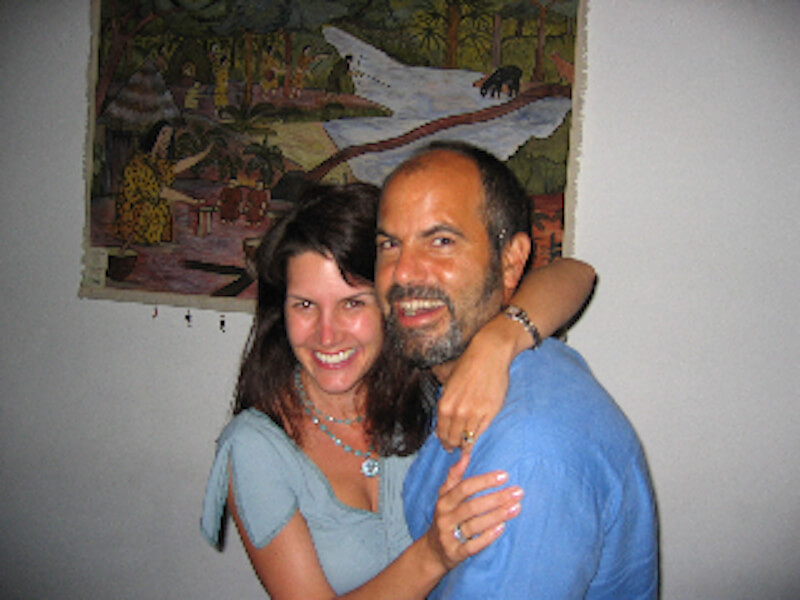
Julianexpat continues exploring his “expat surroundings” for amazingly interesting stories…
I was recently invited to the furniture factory of Gerry and Petie Cooklin in the Zarate barrio of Lima. Gerry is Peruvian and Petie American, and both have lived abroad extensively. Their furniture company, “South Cone”, begun in 1987, combines elegant furniture-making with a clearly heartfelt impulse towards environmental responsibility. In 1998, South Cone launched a “Giving Back Program” in which 10% of profits have subsequently gone to environmental research and social responsibility projects. In 2001, they initiated and have since supported a non-profit project of sustainable forestry with the Yaneshi people in the Palcazu valley of the central Peruvian Amazon. In addition they were instrumental in the creation of the “Sustainable Furniture Council” in an attempt to genuinely impact standards within the industry.
Gerry is a larger-than-life character, Petie and Gerry are very engaging and friendly, and my tour of the factory was fascinating. It was clear to me that everyone at “South Cone” enjoys what they do.
Ok – a Peruvian and an American. I know you’ve both travelled extensively. How did you meet?
We met at a trade show in North Carolina back in 1992. I was selling high end textiles, basically expensive sheets – and Gerry was selling beautiful beds and we decided to get together and I guess the combination has worked so far!
Gerry, how did Southcone come about? When did you start?
I studied chemical engineering in England. After working for a while as an engineer, I figured I wasn’t going to make much money, so I decided to do an MBA in the States. When I graduated, I had worked for a couple of years, enough to know that I didn’t want to work for anybody else.
I wanted to do something on my own and I wanted to do something relating to South America, because I love South America and I wanted an excuse to come back and forth. I tried many products but handcrafts were what really ended up appealing to me. They had good margins.
I started out creating elaborately patterned mirrors, and started selling them in furniture stores. I continued living in the States, but I would take trips to Peru all the time. I’d spend two months in the States and then come here and spend a month. I’ve done the “ping-pong ball” thing for twenty years! Working with the mirrors in furniture stores led me to thinking maybe I should sell furniture. In furniture stores 90% products furniture 10% accessories, so I decided on furniture. And it went on from there.
Can you tell us how the project grew?
The project grew very quickly. I don’t believe in coincidences, but I ended up in furniture in the way I described before and found out that there weren’t any furniture manufacturers of any significance in Peru. But then again, I knew we had the two most important resources for that industry: amazing wood and wonderful workers. The Peruvian workers are really good if you treat them right and you know how to work with them, and they will give you their hearts and souls – and really do a great job. They are very creative and very artistic. The workforce in the factory here in Lima is about 300.
I started designing some of the furniture, incorporating some of the techniques that were clearly appealing to consumers, but maybe were a little too ethnic or a little too large, and I started tweaking it. I always like to be involved in the design process myself.
Are there specific styles that you know will appeal in North America? Would you say that your furniture has a specifically Peruvian style?
Our market right now is exclusively North America which we need to change because the furniture industry is in crisis in the US at the moment. We tried selling in Europe, but for a variety of reasons it didn’t really work for us.
No, we don’t design traditional Peruvian things. In fact there isn’t really any traditional Peruvian furniture. You start meeting the demand of the market – what the style is. It’s like a fashion industry, clothes etc – things come into fashion, and at the high end of the furniture market it’s a fashion industry. We started out following trends, and from there we became a trend setter, because Gerry is always looking at the fusion of technology and furniture design, as an engineer he’s got that – so we started working wood and leather – I think we really started that trend in the US – or painted furniture a big trend for a while – we were one of the forerunners of that.
Your website talks of a dramatic conversion for Gerry in the Sierra Nevada, where you decided to become heavily involved in sustainable practices. Could you explain what happened and how this has changed the ways in which “Southcone” works.
I do a lot of solo camping. On one of the several trips I’ve taken – I was there with my dog, a trail at 11,000 ft – I saw this huge, beautiful juniper tree, absolutely majestic. As I’m climbing, I remember as I got to the top of the trail, climbing and sweating and I look at this thing – it’s huge, I’m hypnotised by it, and this tree starts talking to me, I start hearing stuff – “hey, you’re in a unique position, you’re a furniture manufacturer, you source your wood out of the rain forest, you could make a difference. And that message went right into my subconscious, DNA, I don’t know what happened.
From that day on, I started researching and started putting a lot of effort into it, and then it drastically influenced our direction. I’ve been sustainability-obsessed – that’s what people think. I’ve been relentless about it. I’ve spent more of our resources than anybody thought that we should, more of my time – but it’s something in which I have no choice – it’s actually the purpose of my life, I am sure. Probably to the detriment of the business – there wasn’t any value at the market level for it – and now there finally is – there are some costs but we’re glad we did it.
Can you tell us more about sustainability, the work of The Forest Stewardship Council and its impact on the industry.
If we’re going to consume the resources sustainably, at the end of the day it’s the consumer that has to demand it. And the problem is that, as much as we have learned in the past what’s happening in the jungle, and however responsible we become at the manufacturing level, we can only be sustainable up to a point. If we sell it to a retailer who doesn’t really know about sustainability, who doesn’t know how to convey the choice the end consumer has, then the whole effort is mute, because it doesn’t reach the end consumer.
At the Sustainable Furniture Council last August, for the first time we did a series of seminars and lectures for 5 days inviting designers and retailers. We had different speakers talk about it and started putting the word out. The work of the Sustainable Furniture Council is principally to put all this information out so that consumers, retailers and manufacturers become more aware of the issues.
In the circle of sustainability, the problem is always at the resource level – not a lot of money is made by the indigenous people at the source. How do you push the value so that more money made at this level? If the consumer starts asking “Is this FSC certified?” then that is how it is driven; when you are creating a demand for sustainable products. The consumer says “I want FSC products”, that then tells the manufacturers – ok – we have to make FSC product. Then if there is demand in FSC forests then finally the value comes back to the forest.
All of a sudden, forests are beginning to become certified because the consumer is asking for it – not because manufacturers became altruistic and have seen the light, but because that is what is being demanded. That’s why our project is called “Conservation makes Cents” – it has to be related to the market or else it’s not going to work.
And finally, scientific consensus indicates that we only have 5-10 years to stabilise a dangerous global climate change, so we don’t have a lot of time – we have to act now to raise this awareness amongst the consumers as to the work that we’re doing.
You initiated and continually support a non-profit project in the Amazon called PaTSPeru. Could you explain a little bit about how the PaTSPeru project works, and what type of crafts are produced.
Following from the tree story – we learned first that we had to become FSC certified. That led us to a greater understanding of what the problem was in the Amazon i.e. that everything is burned. Why are they burning it? – and it’s simply because the people are poor. They don’t know how to make an income. That’s how PaTS came to be – how can we teach these people how to do something better with their forest than burning it. And we took our designers from here to help. Now they are skilled in wood-carving and products include tableware, stools, and candleholders, as well as naturally dyed and hand-painted textiles and wall art.
How did you come to choose the Palcazu valley for the NGO project? Tell us a bit about the Yanesha people and their environment.
Once we learned Forest Certification, we knew we wanted to help provide a model of how to work with indigenous people in sustainability efforts. We researched seven different initiatives that were already underway in Peru. We hired a project director and he took a whole year to present the options to us. We didn’t visit them all. I visited three of them and studied them all, and examined the pros and cons of each.
The Palcazu was interesting because there had been three other major initiatives to work with that geographic location in some kind of poverty elevation improvement and forestry management. One was Nature Conservancy, the other from the WWF. Belaunde (Peruvian President in 1960s and early 1980s) had had a vision of making the Palcazu valley “El vallee de la leche para Lima”.
So efforts had already been made. They were already ahead of the curve, and therefore we decided to join onto something that already existed – and it was protected by National Forest, so we got to protect more. If we protected the valley (220,000 hectares we were automatically protecting more than 600,000. There’s a very specific reason for the Palcazu valley. The biggest reason – the moment I set foot in it, I fell in love with the place. It is so gorgeous. “PaTS” is a non-profit. We make no money out of it. But it’s so much fun – and if it can tie into my other work with Southcone it’s a great virtual circle – a win/win for everybody.
Have you had any interesting adventures on your trips into the Amazon over the years?
Oh, many adventures, and I love adventures. In reality it’s an adventure every time he goes there. He comes back with stories about the “shuchupe”, which is the giant snake, crossing rivers in the middle of the night, carrying clothes above your head with no idea what’s in the water. And stories of the visitors who have dared join us…
You’ve both been expatriates at various stages in your lives. Would you say you have found the experience a positive one?
Oh, I would most certainly say yes. I actually thought when I finished my MBA that that was my competitive advantage – the fact that I had lived in several countries and that I can adapt to different cultures and that you can take good things away from each culture. I see myself as a pretty optimistic guy who likes to find the good things in anything I see, and so I think having lived in 5 different countries, the experience has provided me with a lot of good things to take out. – and indeed has made Southcone what it is, and helped me be married to this wonderful woman here, so I am very happy with my expatriate experience.
Overall and briefly, what would you say is the philosophy of Southcone and PATSPeru?
Well, my motto is, if I can have fun, if I can make money at it and I can contribute to the greater good, then I’m a happy man.
Thank you to Gerry and Petie and we wish you all the best in what is a very worthwhile, not to say critical, endeavour.

